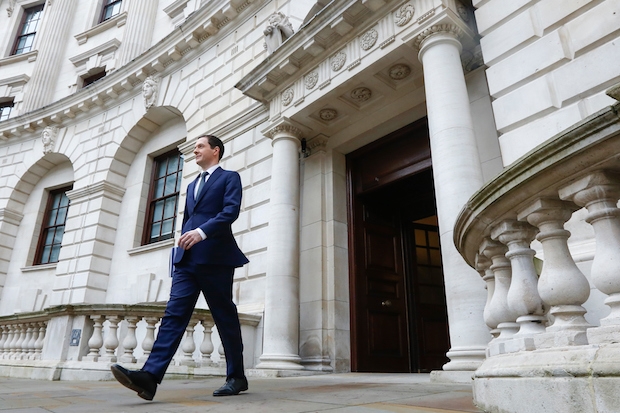Politically, the story was George Osborne’s (wise) retreat on tax credit cuts. Economically, here’s the upshot:-
1. The end of austerity: state spending is shooting up.
[datawrapper chart=”http://static.spectator.co.uk/FOVmc/index.html”]
Everyone expected a hatchet day; instead, this was a tax-and-spend budget. Total state spending is now on the rise, and will be for the foreseeable future. The above graph shows the new spending plans (in red) and old (in blue). In his March Budget, the Chancellor was talking about a £30bn cut for public services; this fell to £18bn in his July budget and today it’s £10bn. How does he manage such a retreat, while keeping to his target of a £10bn surplus in 2020?
2. Osborne’s new tax raid.
[datawrapper chart=”http://static.spectator.co.uk/oJg41/index.html”]
For example, there will be a new tax to pay for social care – but levied by councils. An £11bn tax on companies, called an ‘apprenticeship levy’. Stamp duty hiked up 3pc for buy-to-let landlords and second home buyers. Such taxes will allow Osborne to say that he’ll still run a £10bn surplus in 2020/21.
3. Winners and losers.
[datawrapper chart=”http://static.spectator.co.uk/WLFHy/index.html”]
This is what today was supposed to be all about. Councils have been clobbered, again. Overseas aid does best, naturally. But there is far less pain than expected; defence is up by 3pc, for example. And here’s a puzzle: the police are apparently protected from cuts, but the Home Office budget is down 5pc.
4. So the UK government will now give more away on foreign aid than it will spend policing the streets.
[datawrapper chart=”http://static.spectator.co.uk/WbPux/index.html”]
5. The tax credit cuts abandoned – and it’s affordable.
[datawrapper chart=”http://static.spectator.co.uk/QPw6z/index.html”]
When Osborne was defending his tax credit cuts, he was fond of saying that the move was essential to balancing the books. That his tin-eared critics had to realise there was no money left. In reality, this cruel policy was always expendable . Abandoning it will cost £3.5bn this year, falling to just £0.5bn by 2020 – ie, 0.06pc of state spending. Cutting tax credits, rather than phasing in a new system, was never fiscally necessary. As we now know.
6. The deficit is nudged up. Again.
[datawrapper chart=”http://static.spectator.co.uk/c7RCy/index.html”]
The extra taxes won’t pay for all of his spending splurge; so – as with so many times in the past – the Chancellor is letting his deficit plan slip.
7. Osborne quietly buries his election-time pledge for 2m new jobs.
[datawrapper chart=”http://static.spectator.co.uk/v5y92/index.html”]
When delivering his post-election Budget in July, he still clung to his election-time pledge that he planned to “create two million more jobs on the road to full employment.” How so? He never explained: the projection has always been for one million jobs. Quietly, today, the Chancellor made his peace with reality by saying “more than a million extra jobs will be created over the next five years.” An impressive number – but still, I look forward to the moment when an interviewer asks him to explain the discrepancy.
8. QE – and the debt interest trick
[datawrapper chart=”http://static.spectator.co.uk/oAwbb/index.html”]
Another source of Osborne’s peculiar good luck has been the windfall from debt interest. Remember, the Chancellor is still borrowing like a drunken Keynsian – the UK deficit is the worst in the world save for Spain and Japan. So if global interest rates fall, he saves a bomb. The OBR estimates the 2020 interest rates he’ll pay will be closer to 3.1pc than 3.3pc; this tiny revision saves a lot because of the sheer amount he’s borrowing. But the Bank of England recently said it would only start to unwind QE after interest rates hit 2pc – so the cost of this process has been deferred. Result: Osborne has been served up with another £19 billion, which has today been spent at once.
9. Britain’s economic recovery is now the best in Europe
[datawrapper chart=”http://static.spectator.co.uk/VHRyi/index.html”]
Which is saying something because, not so long ago, it was the worst.
10. And the cheap debt party just keeps on going with the rate rise pushed ever-further into the future.








Comments